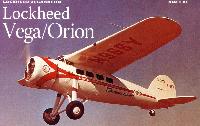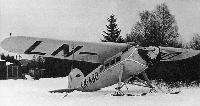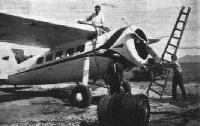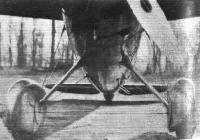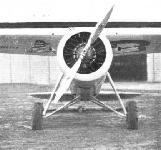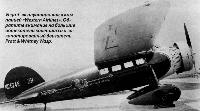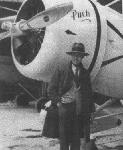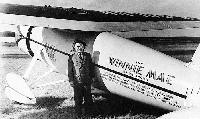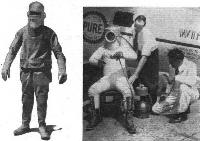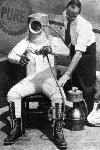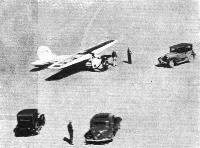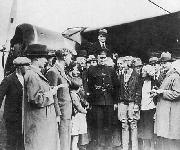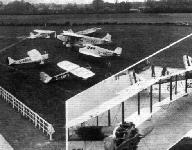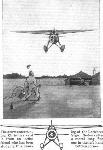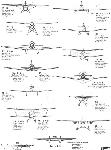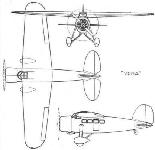
Варианты
- Lockheed - Vega - 1927 - США
- Alcor - Duo-4 / Duo-6 - 1930 - США
Lockheed 1, 2 и 5 Vega
Братья Аллан и Малькольм Локхид (фамилия пишется как Loughead, но произносится как Локхид, что впоследствии нашло отражение в названии новой компании - "Lockheed") увлеклись авиацией в 1910 году, а в начале 1916 года они основали в городе Санта-Барбара, штат Калифорния, свою первую компанию "Loughead Aircraft Manufacturing Company". Через некоторое время компания столкнулась с серьезными финансовыми трудностями, в 1921 году практически прекратила свою деятельность, но в 1926 году на ее базе была организована новая компания, получившая название "Lockheed Aircraft Company". Несмотря на то, что название это просуществовало всего три года, компания сумела за это время запустить в производство самолет Vega, спроектированный Джоном К. Нортропом при участии Жерара Ф. Валти (оба позже создали одну из известнейших американских авиастроительных компаний). Самолет представлял собой свободнонесущий высокоплан деревянной конструкции, имевший изящный обтекаемый фюзеляж типа монокок, состоящий из двух фанерных полуоболочек. Шасси, отличавшееся малым лобовым сопротивлением, имело неубирающееся хвостовое колесо (часто самолеты данного семейства оснащались поплавковым или лыжным шасси), в закрытой кабине размещались пилот и четыре пассажира, а в состав силовой установки первого варианта самолета, позднее обозначенного как Vega 1, вошел звездообразный двигатель Wright J-5 Whirlwind мощностью 225 л. с. Первый самолет поднялся в воздух 4 июля 1927 года, его почти сразу приобрел газетный магнат Джордж Хирст - самолет принял участие в гонках на приз Джеймса Д. Доула по маршруту Окленд - Гавайи, которые стартовали 16 августа 1927 года. Самолет Vega, получивший к тому времени имя Golden Eagle, пилотировали Джек Фрост и Гордон Скотт, однако во время перелета он бесследно пропал - судьба самолета неизвестна до сих пор. Впрочем, это никак не отразилось на продажах, поскольку машина имела удачную конструкцию и хорошие летные данные - в последующие шесть лет возможности Vega стали известны всему миру. Среди достижений самолета были первый трансарктический перелет, первый исследовательский полет над Антарктидой (самолет Vega 1, X3903, пилоты Уилкинс и Илсон), а также первый одиночный трансатлантический перелет из Ньюфаундленда до Ирландии, совершенный женщиной-пилотом (самолет Vega 5B, пилот Амелия Эрхарт), и первый одиночный кругосветный перелет, совершенный женщиной-пилотом (Vega 5B "Winnie Мае", пилот - Уили Пост). К моменту завершения производства было построено 128 самолетов Vega: собственно компания "Lockheed" -115 машин, компания "Detroit Aircraft Corporation" - девять (в 1929-1931 годах компания "Lockheed" была подразделением "Detroit Aircraft Corporation"), а четыре самолета построили другие компании.
Варианты
Vega 1: первый серийный вариант; оснащался двигателями Wright J-5, J-5A, J-5AB, J-5B или J-5C Whirlwind мощностью 225 л.с.
Vega 2: серийный варианте двигателем Wright J-6 Whirlwind мощностью 300 л. с.
Vega 2А: новое обозначение одного из самолетов Vega 2 для полетов с большой полетной массой
Vega 2D: новое обозначение двух самолетов Vega 1 и одного Vega 2 после установки двигателя Pratt & Whitney Wasp Junior мощностью 300 л. с.
Vega 5: основной серийный вариант (построено 35 машин); оснащался двигателями Pratt & Whitney Wasp A мощностью 410 л. с., Wasp B мощностью 450 л. с. или Wasp C1 мощностью 420 л. с.; в основном выпускался с капотом типа NACA с низким лобовым сопротивлением
Vega 5A Executive: доработанный аналог самолета Vega 5 с новым интерьером
Vega 5B: аналог Vega 5, но имел семь мест и большую полетную массу
Vega 5C: аналог Vega 5, но с измененным хвостовым оперением и большей полетной массой
DL-1: вариант Vega 5C с фюзеляжем из легких сплавов; выпускался в то время, когда "Lockheed" входила в состав "Detroit Aircraft Corporation"
DL-1B: аналог DL-1 - транспортный самолет на шесть пассажиров DL-1 Special: один самолет, экспортированный в Великобританию для установления рекордов и участия в авиагонках
Y1C-12: обозначение одного самолета DL-1, приобретенного для оценочных испытаний авиакорпусом Армии США
Y1C-17: обозначение одного самолета DL-1B, приобретенного авиакорпусом Армии США для высокоскоростных полетов и установления рекордов
UC-101: обозначение, данное в ВВС США одному самолету Vega 5C, реквизированному для военной службы в 1942 году
ТАКТИКО-ТЕХНИЧЕСКИЕ ХАРАКТЕРИСТИКИ
Lockheed Vega 5C (сухопутный вариант)
Тип: кабинный моноплан на семь человек
Силовая установка: один звездообразный ПД Pratt & Whitney Wasp SC-1 мощностью 450 л. с. (336 кВт)
Летные характеристики: максимальная скорость 298 км/ч; практический потолок 5485 м; нормальная дальность 885 км
Масса: пустого 1163 кг; максимальная взлетная 2155 кг
Размеры: размах крыла 12,50 м; длина 8,38 м; высота 2,59 м; площадь крыла 25,55 м2
Описание:
- Lockheed 1, 2 и 5 Vega
- Flight, April 1931
THE LOCKHEED "VEGA"
Фотографии
-
Авиация и Время 2012-05 / Н.Терец - "Вега" - первая звезда фирмы "Локхид"
Регистрационный номер: X3903 Vega-1 "Детройт Ньюс" арктической экспедиции X. Уилкинса, 1928 г.
-
Мировая Авиация 114
Регистрационный номер: NR105W [17], NC105W [17] Во время кругосветного перелета 1931 года протяженностью 24 903 км Пост и Гатти совершили 14 посадок. 30 июня при взлете на Аляске едва не произошла авария - был поврежден воздушный винт, который Уили починил при помощи "гаечного ключа, молотка со сломанной ручкой и булыжника".
-
Мир Авиации 1995-02 / М.Маслов - Гонки над Россией /Перелеты/
Регистрационный номер: NR105W [17], NC105W [17] Lockheed Vega "Winni Mae". Перелет В.Поста, июль 1933г.
-
Aeroplane Monthly 1974-02 / Lockheed Vega /Preservation Profile/ (10)
Регистрационный номер: NC105W [17], NR105W [17] -
Авиация и Космонавтика 2013-10 / В.Морозов - Великая воздушная гонка
Регистрационный номер: G-ABGK [7] Локхид "Вега" 5
-
Авиация и Время 2012-02 / В.Морозов - Из Англии в Австралию: дальше уже некогда
Регистрационный номер: G-ABGK [7] Lockheed Vega. Экипаж Дж. Вудс и Д. Беннет
-
Мир Авиации 1995-02 / М.Маслов - Гонки над Россией /Перелеты/
Lockheed Vega . Перелет Д.Маттерна, июнь-июль 1933г.
-
Авиация и Время 2012-05 / Н.Терец - "Вега" - первая звезда фирмы "Локхид"
Регистрационный номер: NC288W DL-1 авиакомпании VAT, который в 1932 г. обслуживал авиалинию Пуэбло - Эль-Пасо
-
Авиация и Время 2012-05 / Н.Терец - "Вега" - первая звезда фирмы "Локхид"
Y1C-17 был в составе 36-й истребительной АЭ в 1932-35 гг.
-
Авиация и Время 2012-05 / Н.Терец - "Вега" - первая звезда фирмы "Локхид"
Регистрационный номер: N47M Гидроплан Vega-5C с мотором P&W R-985. Аляска, Фэрбэнкс, конец 1940-х гг.
-
Мировая Авиация 32
Регистрационный номер: N965Y С самолета Vega началась история некоторых авиакомпаний. Этот реконструированный экземпляр представляет одну из наиболее известных компаний "Varney Speed Lines", предшественницу современной "Continental".
-
Мировая Авиация 32
Благодаря своим высоким летным данным Vega пользовался популярностью у многих авиакомпаний, коммерческих фирм, представителей власти и просто состоятельных людей.
-
Aeroplane Monthly 1997-06 / M.Vines - Kermit weeks's Fantasy of Flight
Регистрационный номер: NC105W [17], NR105W [17] This Lockheed Vega, finished to represent NC-105-W, Wiley Post’s celebrated round-the-world aircraft Winnie Mae, is the sole airworthy specimen of the three surviving examples of the type.
-
Авиация и Время 2012-05 / Н.Терец - "Вега" - первая звезда фирмы "Локхид"
Первый взлет "Веги-1". Лос-Анджелес, 1927 г.
-
Авиация и Время 2012-05 / Н.Терец - "Вега" - первая звезда фирмы "Локхид"
Карл Эйльсон (слева) и Хьюберт Уилкинс возле своей Detroit News
-
Авиация и Космонавтика 2017-03 / В.Морозов - Небо. Женщины. Самолеты
А. Эрхарт на фоне своего самолета Локхид «Вега». Именно на нем она выполнила 20 мая 1932 г. трансатлантический перелет по маршруту Ньюфаундленд - Северная Ирландия
-
Авиация и Время 2009-03 / Н.Терец - Тихоокеанская гонка Доула
Среди неудачников гонки были самолеты "Прайд оф Лос-Анджелес", "Голден Игл" (фото)...
-
Aviation Historian 22 / R.Mulder - Crossing the Deep
Регистрационный номер: LN-ABD [4] Gunnestad (in cockpit) and Thor Bernhoft prepare Lockheed Vega LN-ABD for the flight from Gardermoen to Lympne on October 13, 1933. The sponsors’ names have been displayed prominently on the fuselage, including a panel advertising Selo film beneath the cabin windows, and the logo for “Bensin SNE”, a Soviet-produced fuel.
-
Aviation Historian 22 / R.Mulder - Crossing the Deep
Регистрационный номер: LN-ABD [4] In early July 1929 Lockheed Vega 1 NR33E (c/n 34) was dismantled and placed aboard the Norwegian steamer MS Stavangerfjord, which departed New York for Oslo on July 6, arriving ten days later. It was initially registered N-41 and in May 1932, painted red, it became the first aircraft to be given an LN-series registration, LN-ABD.
-
Aviation Historian 22 / R.Mulder - Crossing the Deep
Регистрационный номер: LN-ABD [4] In August 1934 Gunnestad co-founded Fornebu Flyveselskap to operate air-taxi, charter and pleasure-flying services, chartering LN-ABD from Christensen to join another Vega and Avian LN-ABF in the company’s fleet. By mid-1935 the Vega was back with Christensen, the other machines had crashed and the company folded.
-
Мировая Авиация 32
Регистрационный номер: LN-ABD [4] Первые самолеты Vega оснащались незакапотированными поршневыми двигателями Wright Whirlwind J5 или J6. Самолет на снимке, проданный в Норвегию, демонстрирует свою универсальность, используя лыжное шасси.
-
Air Enthusiast 2001-07 / C.Justo - Ten Out of Ten
Регистрационный номер: X4769 [2] Typical of Lockheed design philosophy prior to the Electra, Lockheed Vega 5 X4769 'Yankee Doodle' flown in August 1928 on the first eastbound non-stop trans-USA flight by Arthur Goebel and Harry Tucker
-
Авиация и Время 2012-05 / Н.Терец - "Вега" - первая звезда фирмы "Локхид"
Регистрационный номер: X4769 [2] Чарльз Колльер и Гарри Такер у "Веги-1" Yankee Doodle после установления рекорда 25.08.1928 г.
-
Aeroplane Monthly 1983-09 / P.Capon - Capon's Corner
Регистрационный номер: NC934Y Lockheed DL-1A Vega NC934Y arrived at Hamble in Summer 1931 for a European tour.
-
Мировая Авиация 29
Регистрационный номер: NC14236 4 июля 1927г.: "Lockheed Aircraft Company" начала летные испытания нового самолета Vega, который считался одним из самых аэродинамичных для своего времени.
-
Flight 1931-07 / Flight
TOURING IN A "VEGA": Miss Margery Durant has been carrying out a sight-seeing tour round the Mediterranean in her Lockheed "Vega." Our illustration shows the machine collecting "Shells" at Tunis, where a halt was made last May.
-
Flight 1931-04 / Flight
Регистрационный номер: G-ABGK [7] This side view of the Lockheed "Vega" shows the exceptionally clean lines of this machine.
-
Flight 1931-04 / Flight
Регистрационный номер: G-ABGK [7] Three-quarter rear view of Lt.-Comdr. Glen Kidston's Lockheed "Vega," which is fitted with a 450-h.p. Pratt and Whitney "Wasp."
-
Flight 1934-10 / Flight
Регистрационный номер: G-ABGK [7] FILLING-UP: The Lockheed "Vega" (Pratt and Whitney "Wasp" S.C.) being fuelled for the start. Messrs. Woods and Bennet were unlucky, the "Vega" hitting the dust at Aleppo
-
Flight 1931-02 / Flight
Регистрационный номер: G-ABGK [7] Lt. Comdr. Glen Kidston (left) with his Lockhead "Vega" monoplane (450 h.p. Pratt and Whitney "Wasp") which he "tried out" at Croydon last week. Lt. Cathcart Jones also took a turn at the "stick." Note, from the two views on the right, the N.A.C.A. cowling and the very neat metal monocoque fuselage.
-
Flight 1931-04 / Flight
The neat landing chassis (Goodyear tyres) and the N.A.C.A. cowling of the Lockheed "Vega."
-
Flight 1931-05 / Flight
The new low drag undercarriage on the "Speed Vega."
-
Flight 1931-04 / Flight
Front view of the Lockheed "Vega" showing the landing chassis and "Wasp" engine.
-
Flight 1934-08 / Flight
The "Vega" (" Wasp" SC1)
-
Air International 1987-07 / Talkback
The "Lady Southern Cross” in company with a Vega and an Orion.
Другие самолёты на фотографии: Lockheed Orion 9 - США - 1931Lockheed Sirius / Altair 8 - США - 1929
-
Мировая Авиация 173
Регистрационный номер: NC624E Vega 5 эксплуатировался компанией "Western Airlines". Обратите внимание на большие обтекатели колес шасси и закапотированный двигатель Pratt & Whitney Wasp.
-
Jane's All the World Aircraft 1980 / Encyclopedia of Aviation - Aircraft A-Z - v4
Регистрационный номер: N199E Lockheed Vega.
-
Air Pictorial 1955-05 / Photos by request
LOCKHEED Y1C-12. Produced in 1931 , the "one-off" Y1C-12 "Army Vega" was a four-seat cantilever high-wing monoplane with a Pratt and Whitney R-1340-7 radial of 450 h.p. It was based on the Fokker DL-1 and was built by Loughead (later Lockheed) then a division of the Detroit Aircraft Corporation. Span was 41 ft.; length 20 ft. 7 in.; gross weight 4,402 lb. ; and top speed 179 m.p.h.
-
Air Pictorial 1961-12
Регистрационный номер: N174D Built thirty-two years ago, this Lockheed Vega is being used to help in tests with new U.S. radar ground equipment. Made almost entirely of wood, she has low radar reflectivity and can still touch 180 m.p.h. and climb to 20,000 ft. Known as "Old 72", her serial number, she and three others are all that remain of the 130 Vegas built
-
Авиация и Космонавтика 2018-02 / В.Морозов - Авиация Литвы: 1919-2018гг. (2)
Регистрационный номер: NR926Y Феликсас Вайткус (стоит слева в летном шлеме) на фоне самолета Локхид L-5B «Вега» накануне трансатлантического перелета «Литуаники-II», сентябрь 1935 г.
-
Авиация и Космонавтика 2018-02 / В.Морозов - Авиация Литвы: 1919-2018гг. (2)
«Литуаника-II» с опознавательными знаками ВВС Литвы. Фото 1938 г.
-
АС 1993-01 / М.Хайрулин - Крылья Литвы /Авиация стран мира/
"Lituanica II" на авиационном празднике в Каунасе летом 1937г.
-
Авиация и Космонавтика 2013-10 / В.Морозов - Великая воздушная гонка
Еще один австралиец, Джимми Вудс, уверенно позирует накануне старта возле своей "Веги", но выйдет из гонки после неудачной посадки в Алеппо
-
Air Pictorial 1957-03 / Photos by request
Регистрационный номер: NR869E Barnstorming Jimmy Mattern's fabulous Vega 5 Special "Century of Progress" (c/n. 69; NR-869-E) featured an unrivalled (Vega) paint finish - the Bald Eagle was bright blue with white outlining, against a bright red background. Compare with a "one-off" Vega S Special
-
Мир Авиации 1995-02 / М.Маслов - Гонки над Россией /Перелеты/
Д.Маттерн в Москве, 1933г.
-
Flight 1933-07 / Flight
Регистрационный номер: NR105W [17], NC105W [17] Wiley Post and his Lockheed "Vega" Winnie Mae.
-
Jane's All the World Aircraft 1980 / Encyclopedia of Aviation - 1. Chronology
Регистрационный номер: NR105W [17], NC105W [17] Winnie Mae replica (23 June - 1 July 1931).
-
Aeroplane Monthly 1974-02 / Lockheed Vega /Preservation Profile/ (10)
Регистрационный номер: NR105W [17], NC105W [17] Gatty (left) and Post at Burbank during 1931 world flight
-
Aeroplane Monthly 1974-02 / Lockheed Vega /Preservation Profile/ (10)
Регистрационный номер: NR105W [17], NC105W [17] Post at Berlin, July 16, 1933, during solo world flight.
-
Мировая Авиация 114
Регистрационный номер: NR105W [17], NC105W [17] Уили Пост около самолета "Winnie Mae" после второго кругосветного перелета.
-
Flight 1933-07 / Flight
Регистрационный номер: NR105W [17], NC105W [17] WINNIE MAE - WINNIE DID: Wiley Post's Lockheed "Vega" (Pratt & Whitney "Wasp") which for the second time has done a "left-hand circuit" of the Northern Hemisphere. His second trip was completed in 7 days 18 hr. 50 min., thus bettering his first by 21 hr. 1 min.
-
Мир Авиации 1995-02 / М.Маслов - Гонки над Россией /Перелеты/
Регистрационный номер: NR105W [17], NC105W [17] Прилет Вилли Поста в Москву, 1933г.
-
Мир Авиации 1995-02 / М.Маслов - Гонки над Россией /Перелеты/
Регистрационный номер: NR105W [17], NC105W [17] В.Пост на Центральном аэродроме, Москва, 1933г.
-
Flight 1934-09 / Flight
Регистрационный номер: NR105W [17], NC105W [17] NOT A DEEP-SEA DIVER! We have already referred to the special flying suit which Wiley Post will wear for flights into the stratosphere. Above are two such suits, that on the right containing, in addition to air from the supercharger, Wiley Post himself.
-
Flight 1935-03 / Flight
Регистрационный номер: NR105W [17], NC105W [17] Wiley Post, the American pilot who has recently made several high-altitude flights, wearing his special suit which is supplied with air from one of the engine superchargers. The air is led to the helmet and exhausts via the boots
-
Aeroplane Monthly 1983-01 / B.Gunston - The classic aero engines (5)
Регистрационный номер: NR105W [17], NC105W [17] THE NEW "WINNIE MAE": Wiley Post's Lockheed "Vega," Winnie Mae, as modified for his trans-continental stratosphere flight. The undercarriage is dropped immediately on taking off, and landing is accomplished on a skid on the bottom of the fuselage. Post's first attempt at this flight failed.
The ultimate Winnie Mae, supercharged for substratosphere flights, 1935
Wiley Post's Wasp-powered Lockheed Vega, NR105W, Winnie Mae, in which he and Harold Gatty flew round the world in just over eight days. -
Flight 1935-03 / Flight
Регистрационный номер: NR105W [17], NC105W [17] A "ONE-POINT LANDING": Wiley Post's Lockheed "Vega," Winnie Mae, after landing - minus the undercarriage - in the Mojave Desert, where it was forced down during an attempted stratosphere flight across America. Only slight damage was done to the airscrew. Note the skid mark in the sand.
Forced landing after sabotage, February 16, 1935 -
Aeroplane Monthly 1989-01 / R.Nesbit - What did happen to Amelia Earhart? (1)
Amelia standing in the cockpit of a Lockheed Vega at the 1933 National Air Races.
-
Aeroplane Monthly 1989-02 / R.Nesbit - What did happen to Amelia Earhart? (2)
Эрхарт у самолета Локхид "Вега", специально доработанного для установления рекорда скорости. 1929г.
Amelia in front of her 1929 speed record Lockheed Vega 5A Executive. -
Авиация и Время 2012-05 / Н.Терец - "Вега" - первая звезда фирмы "Локхид"
Регистрационный номер: NR965Y [6], NC965Y [6] "Вега-5" Амелии Эрхарт перед перелетом из Гонолулу в Окленд, 1935 г.
-
Aeroplane Monthly 1989-01 / R.Nesbit - What did happen to Amelia Earhart? (1)
Регистрационный номер: NC965Y [6], NR965Y [6] The red-and-silver Lockheed Vega 5C Special NC965Y in which Amelia became the first woman to fly from Hawaii to California (and the first person to fly solo across the Pacific), in January 1935.
-
Авиация и Время 2012-05 / Н.Терец - "Вега" - первая звезда фирмы "Локхид"
Регистрационный номер: NR965Y [6], NC965Y [6] Амелия преодолевает Северную Атлантику. 20-21 мая 1932г.: в июне 1928 года Амелия Эрхарт стала первой женщиной, преодолевшей Атлантику по воздуху. Почти четыре года спустя, после длительной подготовки она предприняла попытку самостоятельно, в одиночку, совершить перелет по тому же маршруту. 20 мая 1932 года, в пятую годовщину легендарного полета Линдберга, Амелия Эрхарт отправилась в полет на своем самолете Lockheed Vega из Грейс-Харбор, Ньюфаундленд. Вначале полет проходил без происшествий, но с наступлением темноты вышел из строя один из важнейших приборов - высотомер, к полуночи она попала в песчаную бурю, а затем началось обледенение самолета, лобовое стекло которого практически полностью покрылось льдом. Амелия пошла на снижение и как только машина вышла из слоя облачности - ледяной налет исчез, но проблемы на этом не закончились. Вскоре ее самолет вошел в плотный туман. Надо было набирать высоту, но сделать это с неработающим высотомером было непросто. К утру небо несколько очистилось, однако Эрхарт обнаружила, что основные топливные баки почти опустели - она переключилась на резервный бак, чтобы определить место утечки топлива. Париж оказался теперь вне досягаемости, поэтому Амелия направилась в Ирландию и пересекла береговую линию где-то в графстве Мейо, в западной части Ирландии. Здесь она вновь попала в бурю и в 8 часов 40 минут по местному времени, наконец, совершила посадку в поле у города-порта Лондондерри, Северная Ирландия. Полет продолжался 13 часов 28 минут.
Amelia Earhart arrives in Londonderry (20-21 May 1932). -
Flight 1932-05 / Flight
Регистрационный номер: NR965Y [6], NC965Y [6] "LADY LINDY'S" LOCKHEED: Miss Earhart's Lockheed "Vega" monoplane in the field outside Londonderry, after the Atlantic crossing.
-
Авиация и Время 2005-04 / А.Мандель - Первая леди Атлантики /Портреты/
Регистрационный номер: NR965Y [6], NC965Y [6] Восторженная встреча Эрхарт после сольного перелета через Атлантику. Лондондерри, 21 мая 1932г.
-
Мировая Авиация 100
Регистрационный номер: NR965Y [6], NC965Y [6] -
Flight 1934-01 / Flight
THE HISTORY MAKERS: Orville Wright, who thirty years ago made the first aeroplane flight at Kitty Hawk, N.C., and Mrs. Amelia Earhart Putnam, the first woman to make a West to East solo flight across the Atlantic, are shown here at the new Franklin Memorial Institute, Philadelphia, standing beneath the 'plane in which Miss Earhart crossed the Atlantic, while beside Wright is the motor of the 'plane in which he made his memorable flight.
Другие самолёты на фотографии: Wright Flyer - США - 1903
-
Air Pictorial 1957-03 / Photos by request
Регистрационный номер: NR496M A "one-off" Vega S Special which was modified for attacks on speed records. The wing was lowered and the angle of attack changed, but equally important was the adoption, for the first time, of the now familiar "bubble" canopy. The inscriptions indicate that NR-496M (c/n. 619) was owned by Crosley Radio Corporation, on loan to the record-breaking aviatrix Ruth Nichols - sponsored by Life Savers Candy.
-
Flight 1932-05 / Flight
Регистрационный номер: G-ABGK [7] SCENES AT HESTON: Some of the commercial aircraft which were on view - ABGK, Lockheed "Vega"; ABLI, Spartan Mailplane; ABEF, Ford; ABDC, Junkers; ABDH and ABFV, "Puss Moths."
Другие самолёты на фотографии: De Havilland Puss Moth / D.H.80 - Великобритания - 1929Ford Tri-Motor / 4-AT / 5-AT - США - 1926Junkers F 13 - Германия - 1919Spartan Cruiser - Великобритания - 1932
-
Авиация и Время 2012-05 / Н.Терец - "Вега" - первая звезда фирмы "Локхид"
Регистрационный номер: X3909 Спуск на воду "Веги" (борт X3909) в ходе антарктической экспедиции Херста, 1929 г.
-
Air Enthusiast 1996-05 / R.Grant - Pemmican & Penguins. The life and times of Silas Alward Cheesman
During the 1929 Wilkins-Hearst Antarctic Expedition, Cheesman became the first Canadian pilot to fly in the Antarctic. Left to right: Parker Kramer, pilot; Sir Hubert Wilkins; ‘Al’ Cheesman; Orval Porter, mechanic; on the lashed down Lockheed Vega seaplane.
-
Авиация и Время 2012-05 / Н.Терец - "Вега" - первая звезда фирмы "Локхид"
Участок сборки крыла "Веги"
-
Flight 1929-12 / Flight
Personal Luggage: It is of interest to note that passengers in the French Atlantic liners, SS."Paris," "France" and "Ile de France" may now take their own aeroplanes with them. Our picture shows the first aeroplane to be shipped (on the SS. "Paris" on April 6 last) uncrated as baggage - a Lockhead Vega, belonging to the Standard Oil Co., of New Jersey, on which Capt. E. E. Aldren (Director of Aviation for that company) flew over Europe for the purpose of making an extensive survey of the uses of different motor oils in Europe. A second machine - a Stearman biplane belonging to two Hollywood pilots, Ross Hadley and Chester Loomis - was similarly shipped on the "Ile de France" a fortnight later. We understand about 100 applications to carry such personal luggage had been received, mainly from American tourists who wished to fly in Europe this summer.
-
Авиация и Время 2012-05 / Н.Терец - "Вега" - первая звезда фирмы "Локхид"
Интерьер салона "Веги" вид против полета
-
Авиация и Время 2012-05 / Н.Терец - "Вега" - первая звезда фирмы "Локхид"
Регистрационный номер: NR105W [17], NC105W [17] Авария "Винни Мэ" на Аляске во время кругосветного перелета 26 июня 1933 г.
-
Мир Авиации 1995-02 / М.Маслов - Гонки над Россией /Перелеты/
Авария Д.Маттерна, Анадырь, лето 1933г.
-
Flight 1935-12 / Flight
The above entertaining Christmas card is from an artist friend who has been studying this drawing of the Lockheed Vega. Seekers after a moral may find one in the left-hand bottom corner.
-
Flight 1934-10 / Flight
Другие самолёты на фотографии: Bellanca 28 Flash - США - 1934De Havilland Comet / D.H.88 - Великобритания - 1934De Havilland Fox Moth / D.H.83 - Великобритания - 1932De Havilland Leopard Moth / D.H.85 - Великобритания - 1933Fairey Fox - Великобритания - 1925Harkness & Hillier All Australian - Австралия - 1934Lockheed Sirius / Altair 8 - США - 1929Miles Falcon M.3 / Hawcon M.6 - Великобритания - 1934Monocoupe 90 / 110 / 145 - США - 1930Northrop Delta - США - 1933Percival Gull - Великобритания - 1932Short Scion / S.16 - Великобритания - 1933
-
Flight 1934-08 / Flight
The "Vega" (" Wasp" SC1)
-
Авиация и Время 2012-05 / Н.Терец - "Вега" - первая звезда фирмы "Локхид"
Vega-1 Golden Eagle
-
Авиация и Время 2012-05 / Н.Терец - "Вега" - первая звезда фирмы "Локхид"
Vega-5 Winnie Mae Вилли Поста
-
Авиация и Время 2012-05 / Н.Терец - "Вега" - первая звезда фирмы "Локхид"
Vega-1 Detroit News Хьюберта Уилкинса
-
Авиация и Время 2012-05 / Н.Терец - "Вега" - первая звезда фирмы "Локхид"
Vega-5C (борт. NC47M)
- Фотографии










